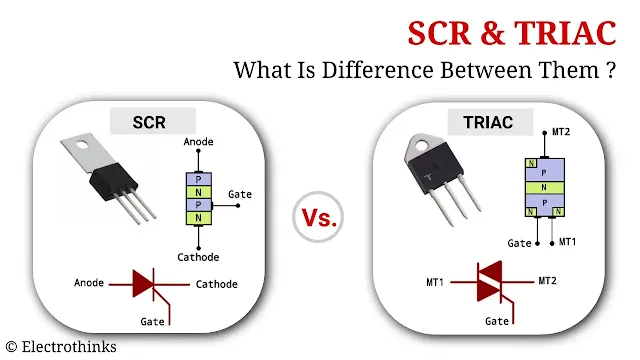
An SCR and TRIAC are the most important semiconductor devices used in power electronics circuits.
The main reason for the difference between SCR and TRIAC is its construction, where SCR is a Unidirectional semiconductor device, but TRIAC is a Bi-Directional semiconductor device.
Following are other difference between SCR (silicon controlled rectifier) and TRIAC (triode for alternating current) :
| SCR | TRIAC |
|---|---|
| SCR stands for "Silicon Controlled Rectifier". | TRIAC stands for "Triode for Alternating Current". |
| SCR construction figure. | TRIAC construction figure. |
| SCR is a three-terminal device; terminals are — Anode, Cathode, Gate. | TRIAC is a three-terminal device, terminals are — MT1, MT2, Gate. |
| Symbol of the SCR. | Symbol of the TRIAC. |
| The SCR conducts current in one direction only, so it is a unidirectional device. | The TRIAC conducts current in both directions, so it is a bidirectional device. |
| It has large current capabilities and available in large ratings. | It is available in smaller ratings as compared to SCR. |
| SCR is mainly used to control DC power. | TRIAC control DC as well as AC power. |
| SCR can be triggered by positive gate voltage only. | TRIAC can be triggered either by the positive or negative gate voltage. |
| In SCR only one mode of operation is possible. | In TRIAC four different modes of operation are possible. |
| It is more reliable. | It is less reliable. |
| An SCR needs two heat sinks. | A TRIAC needs only one heat sink. |
| As the SCR is a Unidirectional Device, so polarity should be maintained when it connects to any circuit. | As the TRIAC is a Bi-Directional Device, so it can be connected in any manner with a circuit. |
| SCR examples: BT169D, 25TTS12, 5P4M, BT151, etc. | TRIAC examples: BT131, MAC97A, BTA24, BTA41, etc. |










No comments
If you have any doubts or questions, please let me know. Don't add links as it goes to spam. Share your valuable feedback. Thanks